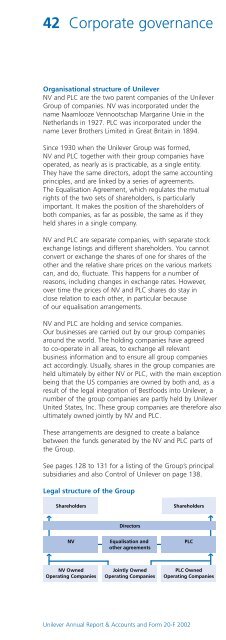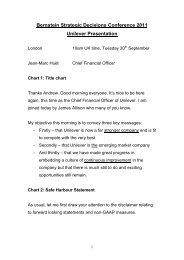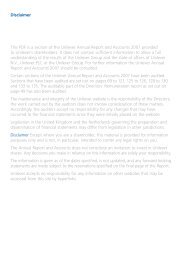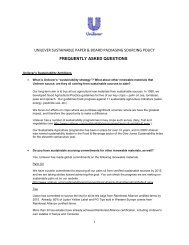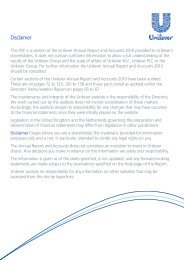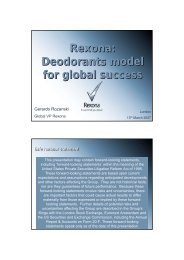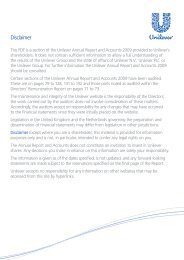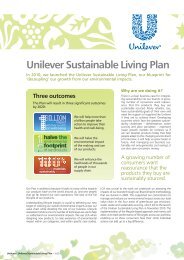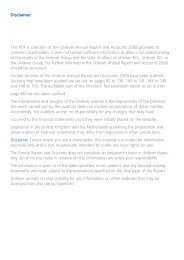Report & accounts 2002 in full - Unilever
Report & accounts 2002 in full - Unilever
Report & accounts 2002 in full - Unilever
You also want an ePaper? Increase the reach of your titles
YUMPU automatically turns print PDFs into web optimized ePapers that Google loves.
15 F<strong>in</strong>ancial <strong>in</strong>struments<br />
The Group has comprehensive policies <strong>in</strong> place, approved by the<br />
directors, cover<strong>in</strong>g the use of derivative f<strong>in</strong>ancial <strong>in</strong>struments. These<br />
<strong>in</strong>struments are used for hedg<strong>in</strong>g purposes. Established controls are<br />
<strong>in</strong> place cover<strong>in</strong>g all f<strong>in</strong>ancial <strong>in</strong>struments. These <strong>in</strong>clude policies,<br />
guidel<strong>in</strong>es, exposure limits, a system of authorities and <strong>in</strong>dependent<br />
report<strong>in</strong>g. Performance is closely monitored with <strong>in</strong>dependent<br />
reviews undertaken by <strong>in</strong>ternal audit. The account<strong>in</strong>g policies<br />
govern<strong>in</strong>g these <strong>in</strong>struments are <strong>in</strong> l<strong>in</strong>e with generally accepted<br />
practice <strong>in</strong> the UK and the Netherlands and follow hedge<br />
account<strong>in</strong>g pr<strong>in</strong>ciples described <strong>in</strong> the account<strong>in</strong>g policies on page<br />
68. The use of leveraged <strong>in</strong>struments is not permitted. Details of the<br />
<strong>in</strong>struments used for <strong>in</strong>terest rate and foreign exchange exposure<br />
management, together with <strong>in</strong>formation on related exposures, are<br />
given below.<br />
Except for the description of <strong>Unilever</strong>’s currency exposures, all<br />
debtors and trade and other creditors have been excluded from the<br />
analysis below and from the <strong>in</strong>terest rate and currency profiles <strong>in</strong><br />
note 14 on page 84 either due to the exclusion of short-term items,<br />
as permitted by United K<strong>in</strong>gdom F<strong>in</strong>ancial <strong>Report</strong><strong>in</strong>g Standard 13,<br />
or because the amounts are not material.<br />
<strong>Unilever</strong> operates an <strong>in</strong>terest rate management policy aimed at<br />
optimis<strong>in</strong>g net <strong>in</strong>terest and reduc<strong>in</strong>g volatility. Derivatives are used<br />
to manage the <strong>in</strong>terest rate exposure of debt and cash positions.<br />
The Group’s f<strong>in</strong>ancial position is largely fixed by fixed rate long-term<br />
debt issues and straightforward derivative f<strong>in</strong>ancial <strong>in</strong>struments such<br />
as <strong>in</strong>terest rate swaps. In general, cash is <strong>in</strong>vested short-term at<br />
float<strong>in</strong>g <strong>in</strong>terest rates.<br />
At the end of <strong>2002</strong> <strong>in</strong>terest rates were fixed on approximately<br />
80% of the projected net debt for 2003 and 47% for 2004<br />
(compared with 54% for <strong>2002</strong> and 47% for 2003 at the end<br />
of 2001).<br />
Nom<strong>in</strong>al values of <strong>in</strong>terest rate derivative <strong>in</strong>struments are shown <strong>in</strong><br />
the table below. These nom<strong>in</strong>al values do not reflect the actual level<br />
of use of f<strong>in</strong>ancial <strong>in</strong>struments when compared with the nom<strong>in</strong>al<br />
value of the underly<strong>in</strong>g debt. This is because certa<strong>in</strong> f<strong>in</strong>ancial<br />
<strong>in</strong>struments have consecutive strike and maturity dates on the same<br />
underly<strong>in</strong>g debt <strong>in</strong> different time periods. Whilst the nom<strong>in</strong>al<br />
amounts reflect the volume of activity, they are not <strong>in</strong>dicative of the<br />
amount of credit risk to which the Group is exposed. For details of<br />
our policy for manag<strong>in</strong>g credit risk see page 38.<br />
<strong>Unilever</strong> Annual <strong>Report</strong> & Accounts and Form 20-F <strong>2002</strong><br />
Notes to the consolidated <strong>accounts</strong> 85<br />
<strong>Unilever</strong> Group<br />
€ million € million<br />
Nom<strong>in</strong>al amounts<br />
at 31 December<br />
<strong>2002</strong> 2001<br />
Interest rate swaps 15 804 21 360<br />
The follow<strong>in</strong>g table shows the extent to which the Group had<br />
unrecognised ga<strong>in</strong>s and losses <strong>in</strong> respect of <strong>in</strong>terest rate <strong>in</strong>struments<br />
at the beg<strong>in</strong>n<strong>in</strong>g and end of the year. It shows the movement <strong>in</strong> the<br />
market value of these <strong>in</strong>struments dur<strong>in</strong>g the year ended<br />
31 December <strong>2002</strong>.<br />
€ million € million € million<br />
Total net<br />
ga<strong>in</strong>s/<br />
Ga<strong>in</strong>s Losses (losses)<br />
Unrecognised ga<strong>in</strong>s and losses:<br />
Balance at 1 January 151 (293) (142)<br />
Brought forward balance<br />
recognised <strong>in</strong> current year 61 (234) (173)<br />
Brought forward balance not<br />
recognised <strong>in</strong> current year 90 (59) 31<br />
Current year items not recognised<br />
<strong>in</strong> current year 210 (145) 65<br />
Balance at 31 December <strong>2002</strong> 300 (204) 96<br />
Expected to be dealt with next year 129 (147) (18)<br />
Expected to be dealt with later 171 (57) 114<br />
The follow<strong>in</strong>g table shows the extent to which the Group has<br />
recognised but deferred ga<strong>in</strong>s and losses <strong>in</strong> respect of <strong>in</strong>terest rate<br />
<strong>in</strong>struments at the beg<strong>in</strong>n<strong>in</strong>g and end of the year. It also shows the<br />
amount which has been <strong>in</strong>cluded <strong>in</strong> the profit and loss account for<br />
the year and those ga<strong>in</strong>s and losses which will be reflected <strong>in</strong> the<br />
profit and loss account <strong>in</strong> 2003 or <strong>in</strong> subsequent years.<br />
€ million € million € million<br />
Total net<br />
ga<strong>in</strong>s/<br />
Ga<strong>in</strong>s Losses (losses)<br />
Deferred ga<strong>in</strong>s and losses:<br />
Balance at 1 January 10 (82) (72)<br />
Brought forward balance<br />
recognised <strong>in</strong> current year 5 (29) (24)<br />
Brought forward balance not<br />
recognised <strong>in</strong> current year 5 (53) (48)<br />
Current year items not recognised<br />
<strong>in</strong> current year – 5 5<br />
Balance at 31 December <strong>2002</strong> 5 (48) (43)<br />
To be recognised <strong>in</strong> the profit and<br />
loss account for next year 5 (25) (20)<br />
To be recognised <strong>in</strong> the profit and<br />
loss account later – (23) (23)<br />
F<strong>in</strong>ancial Statements


